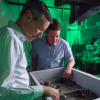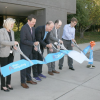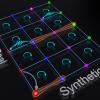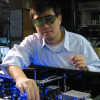Headlines
 CU Boulder and NIST researchers will be better able to coordinate their efforts with the recent opening of the QEI Collaboration Lab on Sept. 26. This new 1,500 square foot space in the Engineering Center will encourage cross-campus research and experiments in the high-impact field of quantum engineering.
CU Boulder and NIST researchers will be better able to coordinate their efforts with the recent opening of the QEI Collaboration Lab on Sept. 26. This new 1,500 square foot space in the Engineering Center will encourage cross-campus research and experiments in the high-impact field of quantum engineering. Physicist Adam Kaufman of both JILA and NIST has been awarded the 2023 New Horizons in Physics Prize from the Breakthrough Prize Foundation for his work in advancing the control of atoms and molecules to improve atomic clocks and quantum information processing.
Physicist Adam Kaufman of both JILA and NIST has been awarded the 2023 New Horizons in Physics Prize from the Breakthrough Prize Foundation for his work in advancing the control of atoms and molecules to improve atomic clocks and quantum information processing. The latest Silicon Valley startup to expand into Colorado, and a CUbit Innovation Partner, Atom already has deep connections with CU Boulder. "It is extremely gratifying to see our recent CU graduates emerge as the early trailblazers of the rapidly growing quantum industry,” said JILA and NIST Fellow Jun Ye.
The latest Silicon Valley startup to expand into Colorado, and a CUbit Innovation Partner, Atom already has deep connections with CU Boulder. "It is extremely gratifying to see our recent CU graduates emerge as the early trailblazers of the rapidly growing quantum industry,” said JILA and NIST Fellow Jun Ye. In a new paper published in PRX Quantum, JILA and NIST Fellow Ana Maria Rey and her team of researchers proposed a new method for seeing the quantum effects enabled by SU(n) symmetry in current experimental conditions, something that has been historically challenging for physicists due to the extremely low temperatures such observations generally require.
In a new paper published in PRX Quantum, JILA and NIST Fellow Ana Maria Rey and her team of researchers proposed a new method for seeing the quantum effects enabled by SU(n) symmetry in current experimental conditions, something that has been historically challenging for physicists due to the extremely low temperatures such observations generally require. A new industry-grade 100 kV electron beam writer (EBPG5150plus) will be the only open-access system of its type in Colorado when operational. The device will improve research around quantum engineering and could be a game-changer for interdisciplinary materials and device research in the region.
A new industry-grade 100 kV electron beam writer (EBPG5150plus) will be the only open-access system of its type in Colorado when operational. The device will improve research around quantum engineering and could be a game-changer for interdisciplinary materials and device research in the region. The merger is addressing pressing needs in quantum research for CU Boulder spinout ColdQuanta—as well as the quantum industry. Both companies are affiliates of Q-NEXT, a U.S. Department of Energy (DOE) National Quantum Information Science Research Center led by Argonne National Laboratory.
The merger is addressing pressing needs in quantum research for CU Boulder spinout ColdQuanta—as well as the quantum industry. Both companies are affiliates of Q-NEXT, a U.S. Department of Energy (DOE) National Quantum Information Science Research Center led by Argonne National Laboratory. The “coherence” time of quantum systems is often measured in milliseconds. By implementing a new type of entangling operation based on Rydberg atoms, JILA Fellow Adam Kaufman and his team have created Bell states with high fidelity, demonstrating optical clock entanglement for up to four full seconds.
The “coherence” time of quantum systems is often measured in milliseconds. By implementing a new type of entangling operation based on Rydberg atoms, JILA Fellow Adam Kaufman and his team have created Bell states with high fidelity, demonstrating optical clock entanglement for up to four full seconds. JILA Fellow Cindy Regal and her team, along with researchers at the National Institute of Standards and Technology (NIST), have for the first time demonstrated that they can trap single atoms using a novel miniaturized version of “optical tweezers”—a system that grabs atoms using a laser beam as chopsticks.
JILA Fellow Cindy Regal and her team, along with researchers at the National Institute of Standards and Technology (NIST), have for the first time demonstrated that they can trap single atoms using a novel miniaturized version of “optical tweezers”—a system that grabs atoms using a laser beam as chopsticks. As the DoD's most prestigious research award, the Vannevar Bush Fellowship is oriented towards "bold and ambitious ‘blue sky’ research that will lead to extraordinary outcomes." Fellows receive $3 million over a five-year fellowship term to pursue cutting-edge fundamental research projects.
As the DoD's most prestigious research award, the Vannevar Bush Fellowship is oriented towards "bold and ambitious ‘blue sky’ research that will lead to extraordinary outcomes." Fellows receive $3 million over a five-year fellowship term to pursue cutting-edge fundamental research projects. “It’s amazing to see all these companies building off of Nobel Prize-winning research,” said Philip Makotyn, executive director of the CUbit Quantum Initiative, which connects quantum researchers and companies in Colorado. “It’s just a rich ecosystem that doesn't exist anywhere else.”
“It’s amazing to see all these companies building off of Nobel Prize-winning research,” said Philip Makotyn, executive director of the CUbit Quantum Initiative, which connects quantum researchers and companies in Colorado. “It’s just a rich ecosystem that doesn't exist anywhere else.”

